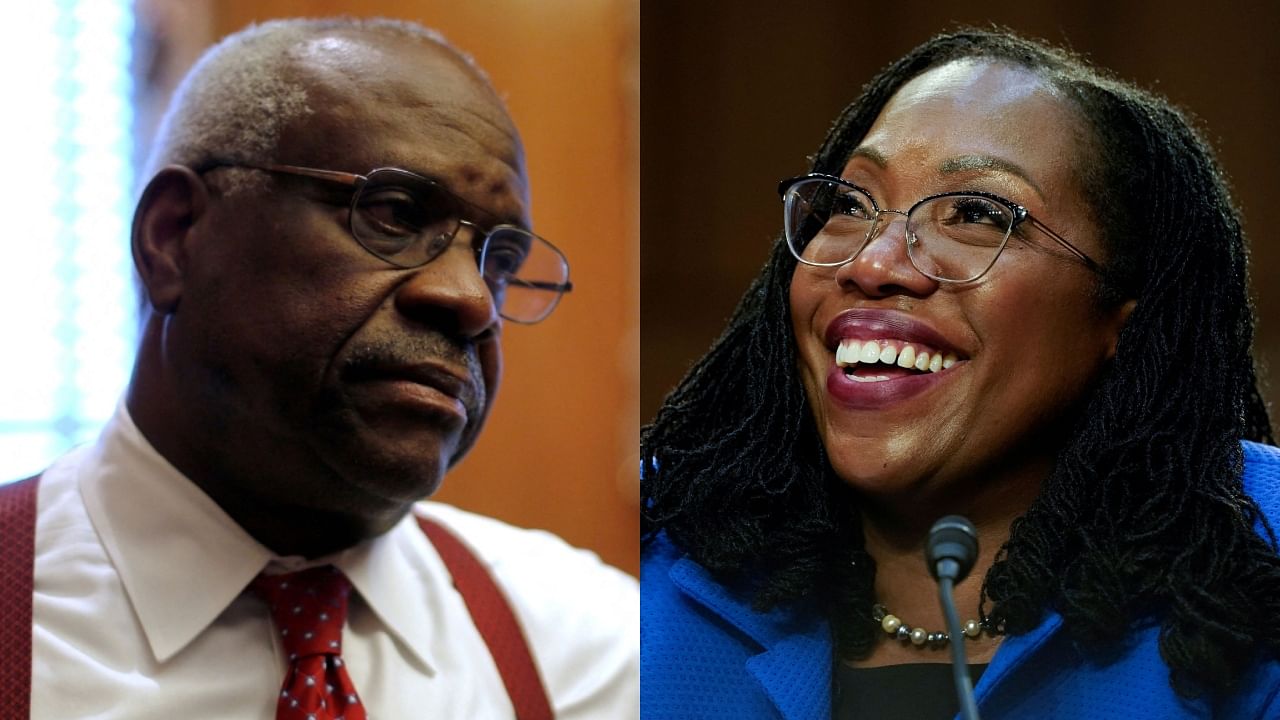
In an extraordinary exchange that played out among the pages of a landmark decision by the Supreme Court declaring race-conscious admissions at colleges and universities across the nation unlawful, two Black justices battled over the merits of affirmative action.
In sharp rebuttals, Justices Clarence Thomas and Ketanji Brown Jackson harshly criticized each other’s perspectives, reflecting the deep divisions and passions Americans have over the practice. Even as they appeared to agree over the policy’s aim — remedying the long-standing discrimination and segregation of Black Americans — they drew opposite conclusions on how and what to do.
Both justices were raised by Black family members who suffered under Jim Crow and segregation, and both gained admission to elite law schools (Jackson to Harvard, Thomas to Yale) before ascending to the Supreme Court. But their interpretation of the law and their understanding of affirmative action and its role in American life could not be further apart.
In his concurring opinion, Thomas called out Jackson directly in a lengthy critique, singling out her views on race and leveling broader criticisms of liberal support for affirmative action.
“As she sees things, we are all inexorably trapped in a fundamentally racist society, with the original sin of slavery and the historical subjugation of Black Americans still determining our lives today,” he wrote.
In her dissent, Jackson pointedly pushed back, denouncing his remarks as a “prolonged attack” that responded “to a dissent I did not write in order to assail an admissions program that is not the one UNC has crafted.”
She agreed that the pair did not disagree on the history or facts about racial disparities in the United States, but that they had reached totally different conclusions. Thomas “is somehow persuaded that these realities have no bearing on a fair assessment of ‘individual achievement,’” she wrote, adding that he “ignites too many more straw men to list, or fully extinguish.”
Their responses in effect amounted to a fight over the lasting legacy of racism and continued discrimination — and how best to address it.
Thomas castigated Jackson’s backing of affirmative action, describing it as a panacea where society would “unquestioningly accede to the view of elite experts and reallocate society’s riches by racial means as necessary to ‘level the playing field.’”
Although he acknowledged that “our society is not, and has never been, colorblind,” he deemed wealth gaps between Black and white Americans “constitutionally irrelevant.” In Jackson’s view, he wrote, “almost all of life’s outcomes may be unhesitatingly ascribed to race.”
He then hit on a recurring theme in his writings and speeches over the years: his anger at Black people being portrayed as victims.
He repudiated statistics showing that the average white family makes much more than the average Black family, arguing that such figures unfairly portray Black people as a monolith.
“This lore is not and has never been true,” he wrote. “Even in the segregated South where I grew up, individuals were not the sum of their skin color.”
He cited a 2016 book by Thomas Sowell, an economist and prominent Black conservative who has influenced Thomas’ philosophy, and he accused Jackson of using “broad observations about statistical relationships between race and select measures of health, wealth and well-being to label all Blacks as victims.”
He continued, “I cannot deny the great accomplishments of Black Americans, including those who succeeded despite long odds.”
Jackson’s viewpoint, he said, would keep Black people locked into “a seemingly perpetual inferior caste.” He called that “an insult to individual achievement and cancerous to young minds seeking to push through barriers, rather than consign themselves to permanent victimhood.”
He also wrote that she was drawing on “race-based stereotypes,” when, in reality, “all racial groups are heterogeneous, and Blacks are no exception — encompassing Northerners and Southerners, rich and poor, and recent immigrants and descendants of slaves.”
By “articulating her black-and-white world (literally),” he added, Jackson ignored the experiences of other groups, including Chinese immigrants, descendants of Holocaust survivors and those who came to the United States from Ireland, fleeing famine.
Jackson pushed back sharply against Thomas, accusing him of imagining her viewpoint and misunderstanding the underpinnings of her support for the policy.
“Gulf-sized race-based gaps exist with respect to the health, wealth and well-being of American citizens,” she wrote. Although those disparities emerged years ago, she added, ignoring that history would be foolish because those inequities have “indisputably been passed down to the present day through the generations.”
Offering a brief history of Jim Crow and the Great Migration, Jackson laid out how Black families struggled against a legal system aimed at preventing them from building wealth — and focused on the strength and fortitude they showed.
“Despite these barriers, Black people persisted,” she wrote.
She invoked the concept of the pink elephant paradox, the idea that once you try not to think about something, it becomes impossible to stop thinking about it. “The takeaway is that those who demand that no one think about race (a classic pink-elephant paradox) refuse to see, much less solve for, the elephant in the room — the race-linked disparities that continue to impede achievement of our great nation’s full potential.”